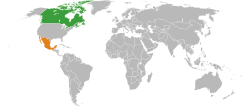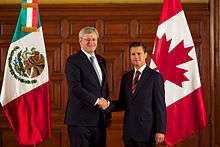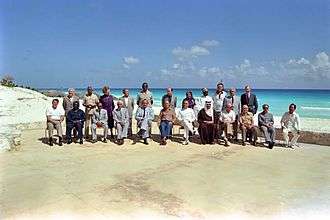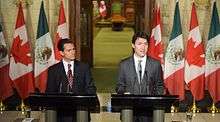Canada–Mexico relations
 |
|
Canada |
Mexico |
|---|---|
| Diplomatic Mission | |
| Embassy of Canada, Mexico City | Embassy of Mexico, Ottawa |
Canada–Mexico relations are relations between Canada and the United Mexican States. Although historic ties between the two nations have been coldly dormant, relations between Canada and Mexico have positively changed in recent years, seeing as both countries brokered the NAFTA. They were on different sides of the Cold War Spectrum (Canada was a member of NATO while Mexico was in the Non-Aligned Movement, though Mexico later left; the two countries were, however, allies in World War II.)
Both nations are members of the Asia-Pacific Economic Cooperation, G-20 major economies, Organization of American States, Organisation for Economic Co-operation and Development and the United Nations.
History
Before Canada became an independent nation, there had been previous contacts between Canada and Mexico in the 1800s. Canadian made products were sold in Mexico under British companies' logos.[1] Since gaining independence from the United Kingdom in 1931; Canada delayed in establishing diplomatic relations with Mexico due to the expropriation of foreign oil companies in 1938. At the time, Canada felt obliged to follow other nations in isolating Mexico economically and diplomatically. Formal relations between the two nations did not begin until 30 January 1944, at the height of Second World War, which both countries participated in on the Allied side. In 1952, Mexico opened its first consulate-general in Montreal.[1]
The first ever reunion between leaders of both nations took place in White Sulphur Springs, West Virginia in 1956 between Mexican President Adolfo Ruiz Cortines, Canadian Prime Minister Louis St. Laurent and American President Dwight D. Eisenhower.[1] In 1959, President Adolfo López Mateos chose to visit Canada on his first official visit abroad. The visit was reciprocated by Prime Minister John Diefenbaker in 1960. Since then, almost every Mexican President has visited Canada at least once and almost every Canadian Prime Minister has visited Mexico.
In 1968, a joint ministerial commission was set up by both nations to meet every two years to discuss and analyze mutual interests in promoting development and deepening bilateral relations. In 1974, an agreement was signed between both nations to allow temporary migrant workers from Mexico to work in Canada.[1]
NAFTA and since

In 1990, leaders of Canada, Mexico and the United States began negotiating a free trade agreement that would be known as the North American Free Trade Agreement (NAFTA). Canada had just signed a free trade agreement with the United States in 1988 (FTA) when the US, under President George H. W. Bush, began to negotiate another pact with Mexico under President Carlos Salinas de Gortari. The Canadian government under Prime Minister Brian Mulroney feared that the advantages Canada had through the Canada-US FTA would be undermined, and asked to become a party to the US-Mexican talks.[2] The result was that NAFTA replaced the previous Canada-US FTA. An agreement was reached between all three nations and NAFTA came into effect on 1 January 1994.[1] Since NAFTA has come into force, the two countries have become much more important to each other, and often collaborate when dealing with the United States.
Relations between the two governments were particularly strong during the first decade of the twenty-first century. In October 2006, then President-elect Felipe Calderón visited Ottawa, and Prime Minister Stephen Harper attended the inauguration of President Calderón. The two leaders were ideological allies, both being pro-market conservatives, Calderón of the National Action Party and Harper of the Conservative Party.

In November 2012, President-elect Enrique Peña Nieto also chose to visit Ottawa as a president-elect before taking the presidential oath. In an editorial in the Globe and Mail on that occasion Peña Nieto characterized the relationship before 1994 as one of "mutual benign neglect" but praised the increase in trade and travel between the two countries since NAFTA. He called for increased Canadian foreign direct investment in Mexico, especially in the petroleum industry, though he said that Petróleos Mexicanos, the state oil company, would remain the owner of the resources. As well he called “North American energy security” a “common goal” of both countries. He also pledged to work to reduce drug-related violence in the country and protect visiting Canadians. He also asked Canadians to reconsider a 2009 decision requiring Mexicans to have visas before coming to Canada.[3]
On december 1st, 2016, Canada lifted the visa requirement for Mexican citizens.
Migration
There are thousands of temporary workers who go to Canada from Mexico each year, and many immigrate permanently as well. Recent changes to the immigration Act would allow many to apply for permanent residency after a two-year period which was not the case before.
Starting from July 13, 2009 all Mexican citizens willing to enter Canada must have a visa in advance from any Canadian Embassy or consulate abroad, an action taken by Canada due to increasing refugee petition claims by Mexican visitors. These refugee petition claims by Mexican visitors exceeded 9,500 in the first six months of the Canadian fiscal year 2009.
In 2013, 1.6 million Canadian citizens visited Mexico. During the same time period approximately 130,000 Mexican citizens visited Canada. It is estimated that 50,000 Canadian citizens either temporarily or permanently reside in Mexico.[4] Around 11,000 Canadians are resident in Mexico.[5]
State visits


Prime Ministerial visits from Canada to Mexico[1][6]
- Prime Minister John Diefenbaker (1960)
- Prime Minister Pierre Trudeau (1974, 1976, 1981, 1982)
- Prime Minister Brian Mulroney (1990)
- Prime Minister Jean Chrétien (1994, 1999, 2002, 2003)
- Prime Minister Paul Martin (2004)
- Prime Minister Stephen Harper (2006, 2009, 2012, 2014)
Presidential visits from Mexico to Canada[7]
- President Adolfo López Mateos (1959)
- President Luis Echeverría Álvarez (1973)
- President José López Portillo (1980)
- President Miguel de la Madrid Hurtado (1984)
- President Ernesto Zedillo (1996, 1997, 1999)
- President Vicente Fox (2001, 2005)
- President Felipe Calderón (2007, May & June 2010)
- President Enrique Peña Nieto (2016)
Trade
Twenty years after NAFTA, Mexico is the largest exporter and importer in Latin America. It exports more manufactured goods than all other Latin American countries combined. The country remains highly dependent on exports to the U.S., but it is on a path toward diversification. In 2012, Mexico was Canada’s fifth-largest export destination after the U.S., China, the United Kingdom and Japan, and Canada’s third-largest source of imports after the U.S. and China. In 2014, two-way trade between both nations amounted to $20 billion USD.[8] Canadian multi-national companies such as Bombardier Inc., BlackBerry, Fairmont Hotels and Resorts and Scotiabank operate in Mexico. At the same time, Mexican multi-national companies such as Grupo Bimbo and various beer and tequila products are sold in Canada.
Resident diplomatic missions
|
|
-
Embassy of Canada in Mexico City
-

Embassy of Mexico in Ottawa
See also
References
- 1 2 3 4 5 6 History of diplomatic relations between Mexico and Canada (in Spanish)
- ↑ Foreign Affairs and International trade Canada: Canada and the World: A History - 1984-1993: "Leap of Faith
- ↑ "For Mexico and Canada, there's room to grow". The Globe and Mail. Retrieved 28 April 2016.
- ↑ "Comercio entre México y Canadá supera 20,000 mdd". Retrieved 28 April 2016.
- ↑ "Extranjeros Residentes En México" (PDF). Instituto Nacional de Migración. p. 35. Archived from the original (PDF) on September 24, 2015. Retrieved 15 March 2016.
- ↑ Encuentros entre mandatarios de México y Canadá (in Spanish)
- ↑ Visita de Estado a Canadá: Ceremonia de Bienvenida (in Spanish)
- ↑ "Documento sin título". Retrieved 28 April 2016.
- ↑ "Welcome to the website of the Embassy of Canada in Mexico". Retrieved 28 April 2016.
- ↑ "Consulate General of Canada in Monterrey". Retrieved 28 April 2016.
- ↑ "Consulate of Canada in Guadalajara". Retrieved 28 April 2016.
- ↑ Embassy of Mexico in Ottawa (in English and Spanish)
- ↑ "Bienvenidos al Consulado General de México en Montreal". Retrieved 28 April 2016.
- ↑ "Bienvenidos al Consulado General de México en Toronto". Retrieved 28 April 2016.
- ↑ "Consulado General de México en Vancouver". Retrieved 28 April 2016.
- ↑ "Bienvenidos a la portada". Retrieved 28 April 2016.
- ↑ Oscar Gabriel Mora López. "Inicio". Retrieved 28 April 2016.
